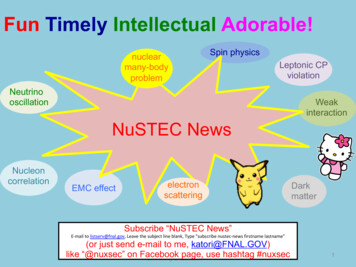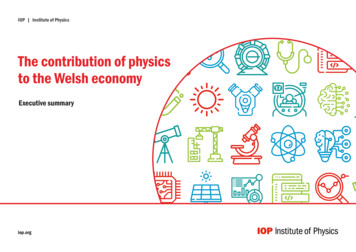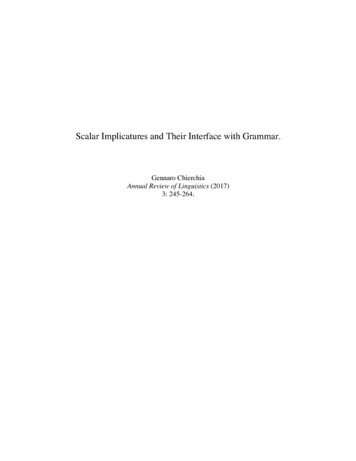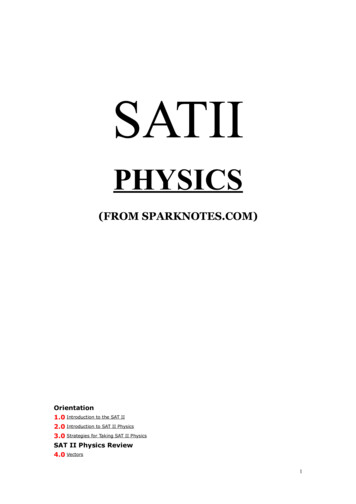
Transcription
Fun Timely Intellectual Adorable!Spin . Introduction2. SIS physics3. A-dep, DIS4. Hadronization5. ConclusionLeptonic CPviolationnucleartargetWeakinteractionNuSTEC NewsNucleoncorrelationEMC effectelectronscatteringDarkmatterSubscribe “NuSTEC News”E-mail to listserv@fnal.gov, Leave the subject line blank, Type "subscribe nustec-news firstname lastname"(or just send e-mail to me, katori@FNAL.GOV)Katori, Queen Marylike “@nuxsec” on TeppeiFacebookpage, use hashtag2018/04/27#nuxsecUniversity of London1
Fun Timely Intellectual Adorable!Spin . Introduction2. SIS physics3. A-dep, DIS4. Hadronization5. ConclusionLeptonic CPviolationnucleartargetWeakinteractionNuSTEC NewsNucleoncorrelationEMC effectelectronscatteringDarkmatterSubscribe “NuSTEC News”E-mail to listserv@fnal.gov, Leave the subject line blank, Type "subscribe nustec-news firstname lastname"(or just send e-mail to me, katori@FNAL.GOV)Katori, Queen Marylike “@nuxsec” on TeppeiFacebookpage, use hashtag2018/04/27#nuxsecUniversity of London2
1. Introduction2. SIS physics3. A-dep, DIS4. Hadronization5. ConclusionChallenges of modelling neutrino induced shallowinelastic scattering (SIS) interactions for neutrinooscillation experiments around 1-10 GeVoutline1. Neutrino Interaction Physics2. Shallow inelastic scattering (SIS)3. Nuclear dependent DIS physics3. Neutrino hadronization process5. ConclusionTeppei KatoriQueen Mary University of LondonNuSTEC nuS&DIS workshop, GSSI, L’Aquila, Italy, Oct. 11, 2018Subscribe “NuSTEC News”E-mail to listserv@fnal.gov, Leave the subject line blank, Type "subscribe nustec-news firstname lastname"(or just send e-mail to me, katori@FNAL.GOV)Teppei Katori,like “@nuxsec” on Facebookpage, use hashtag2018/10/11#nuxseckatori@fnal.gov3
1. Introduction2. SIS physics3. A-dep, DIS4. Hadronization5. ConclusionAlvarez-Ruso et al, Prog.Part.Nucl.Phys.100(2018)11. Neutrino interaction physics2. Shallow-Inelastic scattering (SIS)3. Nuclear-dependent DIS physics4. Neutrino hadronization process5. ConclusionTeppei Katori, katori@fnal.gov2018/10/114
Jon Link, Fermilab Wine & Cheese seminar (2005)Neutrino cross section measurement, 30 years ago1. Introduction2. SIS physics3. A-dep, DIS4. Hadronization5. Conclusion(1) Measure interaction rate(2) Divide by known cross section to obtain flux(3) use this flux, measure cross-section frommeasured rateWhat you get? OF COURSE the cross sectionyou assume!Progress of science is slow, but we haveTeppei Katori, Queen Mary Universityof London5achievedso many2018/04/27things in last 30 years!
1. Introduction2. SIS physics3. A-dep, DIS4. Hadronization5. ConclusionTK, Martini, JPhysG45(2017)11. Typical neutrino detectorsNeutrino scatteringElectron scattering- Wideband beam- well defined energy, well known fluxà Need to predict every processes à reconstruct energy-momentum transferà kinematics is completely fixedspectrometerneutrinobeamtarget( media)electronbeamTeppei Katori, Queen MaryUniversity of Londontarget2018/04/276
1. Introduction2. SIS physics3. A-dep, DIS4. Hadronization5. ConclusionTK, Martini, JPhysG45(2017)11. Typical neutrino detectorsNeutrino scatteringElectron scattering- Wideband beam- well defined energy, well known fluxà Need to predict every processes à reconstruct energy-momentum transferà kinematics is completely fixedP2 experiment LoI (Mainz)arXiv:1802.04759neutrinobeamtarget( media)Teppei Katori, Queen MaryUniversity of London2018/04/277
1. Introduction2. SIS physics3. A-dep, DIS4. Hadronization5. ConclusionTK, Martini, JPhysG45(2017)11. Typical neutrino detectorsNeutrino scatteringElectron scattering- Wideband beam- well defined energy, well known fluxà Need to predict every processes à reconstruct energy-momentum transferà kinematics is completely fixedP2 experiment LoI (Mainz)arXiv:1802.04759neutrinobeamtarget( media)Incomplete kinematics- Neutrino energy is reconstructed, not measured- Reconstructing kinematics (Ev, Q2, W, x, y, ) in 1-10 GeV are model dependent- Large mass, coarse instrumentation, not every final state particles are measuredNeutrino interaction physics incomplete measurement1. Neutrino kinematics are under-constrained2. Neutrino cannot choose target, need simulations of all materialsTeppei Katori, Queen Mary2018/04/2783. Detectorsare ofcoarse,UniversityLondon incomplete final state measurements
Formaggio and Zeller, Rev.Mod.Phys.84(2012)13071. Next generation neutrino oscillation experiments1. Introduction2. SIS physics3. A-dep, DIS4. Hadronization5. ConclusionNeutrino oscillation experiments, present to future- T2K, NOvA, Fermilab SBN, PINGU, ORCA, Hyper-Kamiokande, DUNE Reactors 4MeVT2K/Hyper-KNOvAMINOS DUNEPINGUORCAMicroBooNESBNDICARUSnµCC cross section per nucleon#L(km) &2222P(L/E) sin2θsin1.27Δm(eV)%(µ eTeppei Katori,katori@fnal.gov2018/10/119E(GeV)'
MiniBooNE: PRD81(2010)092005, Martini et al,PRC80(2009)065501TK and Martini, JPhysG45(2018)0130011. Discovery of nucleon correlation in neutrino scattering1. Introduction2. SIS physics3. A-dep, DIS4. Hadronization5. Conclusion- Significant enhancement of crosssection (10-30%) around 1 GeV- Modify lepton kinematics andfinal state hadrons- The hottest topic for T2K,MINERvA, MicroBooNE, etcWhat experimentalists call“CCQE” is not genuineCCQE!MarcoMartini(Saclay)Particle Data Group- Section 42, “Monte Carlo Neutrino Generators” (Hugh Gallagher, Yoshinari Hayato)- Section 50, “Neutrino Cross-Section Measurements” (Sam Zeller)The first textbook of neutrino interaction physics!“Foundation of Nuclear and Particle Physics”- Cambridge University Press (2017), ISBN:0521765110- Authors: Donnelly, Formaggio, Holstein, Milner, Surrow3: Sensitivity to oscillation parameterMatt MuetherTeppei Katori, katori@fnal.govChristophe Bronner2018/10/1110
QE1. Beyond QE peakSISRES1. Introduction2. SIS physics3. A-dep, DISDIS4. Hadronization5. ConclusionAxial 2-body current in QE region may be a tip of theiceberg Axial 2BC in QE regionTeppei Katori, katori@fnal.gov2018/10/1111
QE1. Beyond QE peakSISRES1. Introduction2. SIS physics3. A-dep, DISDIS4. Hadronization5. ConclusionAxial 2-body current in QE region may be a tip of theiceberg , or maybe tip of gozillaAxial 2BC in QE regionShallow Inelastic Scattering PhysicsTeppei Katori, katori@fnal.gov2018/10/1112
1. IntroductionSession 2: Generators2. SIS physics3. A-dep, DISKai Gallmeister4. Hadronization5. ConclusionJulia Tena VidalJan SobczykChristophe BronnerTeppei Katori, katori@fnal.gov2018/10/1113
1. Introduction2. SIS physics3. A-dep, DIS4. Hadronization5. ConclusionAlvarez-Ruso et al, Prog.Part.Nucl.Phys.100(2018)11. Neutrino interaction physics2. Shallow-Inelastic scattering (SIS)3. Nuclear-dependent DIS physics4. Neutrino hadronization process5. ConclusionTeppei Katori, katori@fnal.gov2018/10/1114
Nakamura et al.,Rep.Prog.Phys.80(2017)056301Traditionally called “transition” region2. Sallow Inelastic Scattering (SIS) physics1. Introduction2. SIS physics3. A-dep, DIS4. Hadronization5. ConclusionBasic ingredients1. D(1232)-resonance2. higher resonances3. non-resonant background4. low Q2 , low W DIS5. Nuclear dependent DIS6. Neutrino hadronizationD(1232)higher resonancesnon-resonant backgroundGENIE v2.8.6(or w, or q0 )The first textbook of neutrino interaction physics!“Foundation of Nuclear and Particle Physics”- Cambridge University Press (2017), ISBN:0521765110- Authors:Donnelly, Formaggio, Holstein,Milner, SurrowTeppei Katori,katori@fnal.gov2018/10/1115
2. Physics of D resonanceBasic ingredients1. D(1232)-resonance2. higher resonances3. non-resonant background4. low Q2 , low W DIS5. Nuclear dependent DIS6. Neutrino hadronizationD(1232)1. Introduction2. SIS physics3. A-dep, DIS4. Hadronization5. ConclusionGiessen BUU transport model(GiBUU) describes final states ofhadrons in nuclear mediaUlrichMosel(Giessen)MiniBooNE CC1po datahigher resonancesnon-resonant backgroundGENIE v2.8.6Session 4: Pion productionMinoo KarbinezhadSteve DytmanCC1po productionnZDTeppei Katori, katori@fnal.govnµpop2018/10/1116
2. Physics of D resonanceBasic ingredients1. D(1232)-resonance2. higher resonances3. non-resonant background4. low Q2 , low W DIS5. Nuclear dependent DIS6. Neutrino hadronizationD(1232)1. Introduction2. SIS physics3. A-dep, DIS4. Hadronization5. ConclusionGiessen BUU transport model(GiBUU) describes final states ofhadrons in nuclear mediaMiniBooNE CC1po datapion scatteringp N à p NUlrichMosel(Giessen)higher resonancesnon-resonant backgroundGENIE v2.8.6Session 4: Pion productionMinoo KarbinezhadSteve DytmanCC1po productionnZDTeppei Katori, katori@fnal.govnµpop2018/10/1117
2. Physics of D resonanceBasic ingredients1. D(1232)-resonance2. higher resonances3. non-resonant background4. low Q2 , low W DIS5. Nuclear dependent DIS6. Neutrino hadronizationD(1232)1. Introduction2. SIS physics3. A-dep, DIS4. Hadronization5. ConclusionGiessen BUU transport model(GiBUU) describes final states ofhadrons in nuclear mediaMiniBooNE CC1po datapion scatteringp N à p NUlrichMosel(Giessen)higher resonancespion absorptionp NàD NàN Nnon-resonant backgroundGENIE v2.8.6Session 4: Pion productionMinoo KarbinezhadSteve DytmanCC1po productionnZDTeppei Katori, katori@fnal.govnµpop2018/10/1118
2. Physics of D resonanceBasic ingredients1. D(1232)-resonance2. higher resonances3. non-resonant background4. low Q2 , low W DIS5. Nuclear dependent DIS6. Neutrino hadronizationD(1232)1. Introduction2. SIS physics3. A-dep, DIS4. Hadronization5. ConclusionGiessen BUU transport model(GiBUU) describes final states ofhadrons in nuclear mediaMiniBooNE CC1po datapion scatteringp N à p Ncharge exchangep nàpo ppion absorptionp NàD NàN NUlrichMosel(Giessen)higher resonancesnon-resonant backgroundGENIE v2.8.6CC1po productionnUnderstanding of single pionproduction is already very toughZDTeppei Katori, katori@fnal.govnµpopCC1p productionnZ2018/10/11NDµp 19N
Nakamura et al,Rep.Prog.Phys.80(2017)0563012. Physics of higher resonancesDCC model vs. electro-pion-production data1. Introduction2. SIS physics3. A-dep, DIS4. Hadronization5. ConclusionBasic ingredientsSession 4: Pion prod. W Delta1. D(1232)-resonanceSatoshi Nakamura2. higher resonances3. non-resonant background4. low Q2 , low W DIS5. Nuclear dependent DIS6. Neutrino hadronizationD(1232)higher resonancesnµpDCC model exclusive channel predictionnon-resonant backgroundGENIE v2.8.6DCC model- Total amplitude is conserved- Channels are coupled (pN, ppN, etc)- 2 pion productions 10% at 2 GeV- not yet available in generatorsRole of high W resonances in neutrinoexperiments is not understood (andTeppei Katori, katori@fnal.govprobably modeled incorrectly)2018/10/1120
Rodrigues,Wilkinson,McFarland,EPJC76(2016)4742. Physics of non-resonant backgroundBasic ingredients1. D(1232)-resonance2. higher resonances3. non-resonant background4. low Q2 , low W DIS5. Nuclear dependent DIS6. Neutrino hadronizationD(1232)Non-resonant component and resonancesare incoherently added ( wrong, but easyto simulate).Non-resonant background is identified to beDIS at higher W.higher resonancesnon-resonant background1. Introduction2. SIS physics3. A-dep, DIS4. Hadronization5. ConclusionNon-resonant background in GENIE needsto be reduced more than 50%.GENIE v2.8.6If something is wrong beyond Delta, weusuallu blame non-resonant backgroundTeppei Katori, katori@fnal.gov2018/10/1121Session 4:Pion prod. W Delta
Bloom and Gilman, PRL25(1970)1140Graczyk et al,NPA781(2007)227, Lalakulich et al, PRC75(2007)0152022. Quark-Hadron DualityBasic ingredients1. D(1232)-resonance2. higher resonances3. non-resonant background4. low Q2 , low W DIS5. Nuclear dependent DIS6. Neutrino hadronization1. Introduction5: Transition from SIS2. SISto physicsDIS3. A-dep, DISEric Christy4. Hadronization5. ConclusionManny PaschosHuma HeidarNatalie Jachowicz“An average over the resonances isintimately related to the scaling curve”- Manny Paschos (Dortmund)QH-duality- Many studiesTeppei Katori, katori@fnal.gov2018/10/1122
1. IntroductionBloom and Gilman, PRL25(1970)1140Graczyk et al,NPA781(2007)227, Lalakulich et al, PRC75(2007)0152025: Transition from SIS2. SISto physicsDIS3. A-dep, DISEric Christy4. Hadronization5. ConclusionManny PaschosHuma HeidarNatalie Jachowicz2. Quark-Hadron DualityBasic ingredients1. D(1232)-resonance2. higher resonances3. non-resonant background4. low Q2 , low W DIS5. Nuclear dependent DIS6. Neutrino hadronization“ this cannot be true.”- Un-Ki Yang (Seoul National University)QH-duality Bodek-Yang model- Many studies- B-Y model is the only model availablein neutrino generatorNEUTIt is urgent to get correlatedsystematic errors from B-Y modelChristophe BronnerUn-Ki YangGENIETeppei Katori, katori@fnal.gov2018/10/1123
1. Introduction2. SIS physics3. A-dep, DIS4. Hadronization5. ConclusionAlvarez-Ruso et al, Prog.Part.Nucl.Phys.100(2018)11. Neutrino interaction physics2. Shallow-Inelastic scattering (SIS)3. Nuclear-dependent DIS physics4. Neutrino hadronization process5. ConclusionTeppei Katori, katori@fnal.gov2018/10/1124
HKN,PRC76(2007)065207, EPS,JHEP04(2009)065, FSSZ,PRD85(2012)074028nCTEQ, PRD80(2009)0940043. Nuclear dependent DIS processBasic ingredients1. D(1232)-resonance2. higher resonances3. non-resonant background4. low Q2 , low W DIS5. Nuclear dependent DIS6. Neutrino hadronization1. Introduction2. SIS physics3. A-dep, DIS4. Hadronization5. Conclusion6: nuclear medium effectsSajjad AtherSergey KulaginOlek KusinaNuclear PDF- Shadowing, EMC effect, Fermi motion- Theoretical origin is under debate- Various models describe charged lepton data- Neutrino data look very different l -Fe nuclear correction factorn-Fe nuclear correction factorEMC effectshadowinganti-shadowingFermi motionno shadowing?EMC effect at x 0.1?Teppei Katori, katori@fnal.gov2018/10/1125
1. Introduction2. SIS physics3. A-dep, DIS4. Hadronization5. ConclusionMINERvA,PRD93(2016)0711013. Nuclear dependent DIS process12CBasic ingredients1. D(1232)-resonance2. higher resonances3. non-resonant background4. low Q2 , low W DIS5. Nuclear dependent DIS6. Neutrino hadronizationMINERvA DIS target ratio data (C, Fe, Pb)- MINERvA data reveal shadowing effect onneutrino may be larger than expected56FeWe care all nuclear targets- Neutrino beam is like a “shower”, and it interactswith all materials surrounding the vertex detector.MC needs to simulate neutrino interactions (andparticle propagations) for all inactive ectorTeppei Katori, katori@fnal.gov2018/10/1126
1. Introduction2. SIS physics3. A-dep, DIS4. Hadronization5. ConclusionAlvarez-Ruso et al, Prog.Part.Nucl.Phys.100(2018)11. Neutrino interaction physics2. Shallow-Inelastic scattering (SIS)3. Nuclear-dependent DIS physics4. Neutrino hadronization process5. ConclusionTeppei Katori, katori@fnal.gov2018/10/1127
1. IntroductionGuenette (MicroBooNE), Neutrino 20187: neutrino hadronization2. SIS physicsDISStefan Prestel 3.4. A-dep,Hadronization5. ConclusionCostas AndreopoulosPaola SalaKai GallmesiterTeppei Katori4. Neutrino hadronizationBasic ingredients1. D(1232)-resonance2. higher resonances3. non-resonant background4. low Q2 , low W DIS5. Nuclear dependent DIS6. Neutrino hadronizationLArTPC is a high resolution detector to measureexclusive final states of hadrons.Hadron shower measurement (c.f. NOvA)is probably not very sensitive tohadronization modelsTeppei Katori, katori@fnal.gov2018/10/11Matt Meuther28
1. Introduction2. SIS physics3. A-dep, DIS4. Hadronization5. ConclusionKuzmin and Naumov, PRC88(2013)0655014. PYTHIA neutrino hadronizationKuzmin-Naumov fit- They systematically analysed all bubble chamber data- Difference of hydrogen and deuterium data- Presence of kinematic cuts- Better parameterizationAll PYTHIA-based modelsunderestimate averaged chargedhadron multiplicity data(GiBUU, GENIE, NuWro, NEUT)NuWroGENIEGiBUUAverage charged hadron multiplicity with function of W2Teppei Katori, katori@fnal.gov2018/10/1129
1. Introduction2. SIS physics3. A-dep, DIS4. Hadronization5. ConclusionSjostrand, Lonnblad, and Mrenna, hep-ph/0108264Gallmeister and Falter, PLB630(2005)40, TK and Mandalia,JPhysG42(2015)1150044. PYTHIA neutrino hadronizationShivesh Mandalia(Queen MaryàFermilab)Averaged charged hadron multiplicity nch - PYTHIA6 with tuned Lund string function (Lund a , Lund b )can reproduce nch data both neutrino and antineutrino.Lund stringfunctionhadron energy distributionfrom iterative processtSketch of fragmentationfrom q 𝑞% string breakingtunnelling probability𝑓(𝑧) 𝑧 -. (1 𝑧)0 1 𝑒𝑥𝑝 𝑏𝑚78 /𝑧x10 nch nch Neutrino average charged hadron multiplicity15’ ν D2 (1983)8BEBC ν H2 (1981)1015’ ν D2 (1983)8Default6DefaultModified PYTHIA6401Modified PYTHIA4KNO scalingtransition2BEBC ν D2 (1984) PYTHIA610W2(GeV2/c4)ν p µ -X102 201Teppei Katori, katori@fnal.govν n µ -X10210222018/10/11W (GeV/c4)30
TK et al, arXiv:1602.000834. GENIE-PYTHIA8“We don’t support PYTHIA6”- Stephen Mrenna (Fermilab, PYTHIA author)1. Introduction2. SIS physics3. A-dep, DIS4. Hadronization5. ConclusionPYTHIA8 à LHC era generator- initial test shows PYTHIA8 have harder fragmentation model (consistent with LHC energy)- HERMES style tuning ( shift fragmentation function by tuning Lund string function) can fixaveraged charged hadron multiplicity.- Ongoing problem: po-multiplicity and all hadron multiplicity dispersion10 nch nch Neutrino average charged hadron multiplicity15’ ν D2 (1983)8BEBC ν H2 (1981)1015’ ν D2 (1983)8Default6DefaultModified PYTHIA6401Modified PYTHIA4KNO scalingtransition2BEBC ν D2 (1984) PYTHIA610W2(GeV2/c4)ν p µ -X102 201Teppei Katori, katori@fnal.govν n µ -X10210222018/10/11W (GeV/c4)31
1. Introduction2. SIS physics3. A-dep, DIS4. Hadronization5. ConclusionZieminska et al (Fermilab 15’),PRD27(1993)47AGKY model, EPJC63(2009)14. PYTHIA hadron multiplicity dispersionBubble chamber topological cross section dataAlthough averaged charged hadron multiplicity makescontinuous curve, topological cross sections arediscontinuous, because multiplicity dispersion byPYTHIA6 is much narrower than bubble chamber data.charged hadronmultiplicity dispersionn-p topological cross section (GENIE)10 nch nch Neutrino average charged hadron multiplicity15’ ν D2 (1983)8BEBC ν H2 (1981)1015’ ν D2 (1983)8Default6DefaultModified PYTHIA64KNO scaling PYTHIA610W2(GeV2/c4)ν p µ -X1022 scalingKNO01Teppei Katori, katori@fnal.govtransition01Modified PYTHIA4transition2BEBC ν D2 (1984) ν n µ -XPYTHIA610210222018/10/11W (GeV/c4)32
1. Introduction2. SIS physics3. A-dep, DIS4. Hadronization5. ConclusionAlvarez-Ruso et al, Prog.Part.Nucl.Phys.100(2018)11. Neutrino interaction physics2. Shallow-Inelastic scattering (SIS)3. Nuclear-dependent DIS physics4. Neutrino hadronization process5. ConclusionTeppei Katori, katori@fnal.gov2018/10/1133
1. IntroductionSubscribe NuSTEC News mailinglist!2. SIS physicsFacebook:@nuxsec, Twitter:#nuxsec3. A-dep, DIS5. Conclusion: SIS systematics errors for n-oscillationTyperesonancetype of errorSingle pion productionSISNon-resonant backgroundSISBodek-Yang correctionSISHigher resonanceDISdifferential xsDISA-scaling, empiricalDISA-scaling, nuclear PDFHadronizationlow W averaged chargedhadron multiplicityHadronizationhigh W averaged chargedhadron multiplicity4. Hadronization5. ConclusionBasic ingredients1. D(1232)-resonance2. higher resonances3. non-resonant background4. low Q2 , low W DIS5. Nuclear dependent DIS6. Neutrino hadronizationTeppei Katori, katori@fnal.gov2018/10/1134
1. IntroductionSubscribe NuSTEC News mailinglist!2. SIS physicsFacebook:@nuxsec, Twitter:#nuxsec3. A-dep, DIS5. Conclusion: SIS systematics errors for n-oscillation4. Hadronization5. Conclusiontype of errorapproachongoing issuesize of errorSingle pion productionForm factors, external dataon e and nuMiniBooNE-MINERvAdata tensionlarge, butstudied wellSISNon-resonant backgroundExternal data on e and nuNot many studies. Veryphenomenological?SISBodek-Yang correctionChange Bodek-Yangparameters by eyesThere is are correlationson model parametersmaybelarge?SISHigher resonance?MC must be wrong?DISdifferential xsNuTeV-GENIE comparison(bottom-up)Disagreement seen onlyat very low x ( 0.03)1-2% byGENIEDISA-scaling, empiricalMINERvA-GENIE(bottom-up)No understandingMINERvA datamaybelarge?DISA-scaling, nuclear PDFFrom nuclear PDF, CT10?nCTEQ? (top-down)GRV98 is only compatiblewith B-Y correctionexpectedto be smallHadronizationlow W averaged chargedhadron multiplicityChange AGKY modelparametersNot many data.maybelarge?Hadronizationhigh W averaged chargedhadron multiplicitybubble chamber-PYTHIAcomparisonLund string function needto be tune for lowE1-2% byGENIETyperesonanceSome of systematic errors are identified to be dangerous ,TeppeikindKatori,ofkatori@fnal.gov2018/10/1135- Whatsystematic errors do wehave on nuSIS&DIS?
1. Introduction2. SIS physics3. A-dep, DIS4. Hadronization5. ConclusionBack upTeppei Katori, katori@fnal.gov2018/10/1136
1. Introduction2. SIS physics3. A-dep, DIS4. Hadronization5. Conclusion1. Neutrino DIS cross section overviewNeutrino Deep Inelastic Scattering (DIS)- a process to scatter a charged lepton by an incident lepton with given energy- DIS differential cross section is function of x and y- DIS total cross section is function of En, integrated in x and yDISnµqpp Teppei Katori, katori@fnal.govp- 2018/10/1137
1. Introduction2. SIS physics3. A-dep, DIS4. Hadronization5. Conclusion1. Neutrino DIS cross section overviewNeutrino Deep Inelastic Scattering (DIS)- a process to scatter a charged lepton by an incident lepton with given energy- DIS differential cross section is function of x and y- DIS total cross section is function of En, integrated in x and yNeutrino hadronization- a process to generate hadrons from given Q2 and W- number of hadrons (multiplicity) and hadrons kinematics are computed.DISnDIS and Hadronization areusually modelledindependently in simulationµqhadronizationpp Teppei Katori,Teppeikatori@fnal.govKatorip- 2018/10/1138
1. Introduction2. SIS physics3. A-dep, DIS4. Hadronization5. ConclusionFormaggio and Zeller, Rev.Mod.Phys.84(2012)1307MINOS, PRD81(2010)0720021. Neutrino DIS cross section overviewNeutrino Deep Inelastic Scattering (DIS)- a process to scatter a charged lepton by an incident lepton with given energy- DIS differential cross section is function of x and y- DIS total cross section is function of En, integrated in x and yNeutrino hadronization- a process to generate hadrons from given Q2 and W- number of hadrons (multiplicity) and hadrons kinematics are computed.DIS total cross section error few %?!- This is the error of CCDIS total crosssection on iron target around 10 GeV- Most of neutrino oscillationexperiments are neither iron target orthis energy rangeTeppei Katori,Teppeikatori@fnal.govKatori2018/10/1139
AGKY, EPJC63(2009)1TK and Mandalia,JPhysG42(2015)1150042. GENIE SIS modelGENIE is the most widely usedneutrino interaction generator1. Introduction2. SIS physics3. A-dep, DIS4. Hadronization5. ConclusionCross sectionThere are 2 kind of “transitions” in SIS regionW2 2.9 GeV2 : RES- cross-sectionW2 2.9 GeV2 : DIS- hadronizationHadronizationW2 5.3GeV2 : KNO scaling based model2.3GeV2 W2 9.0GeV2 : transition9.0GeV2 W2 : PYTHIA6W2 distribution for H2O target with atmospheric-n flux (GENIE)GENIE v2.8.0DISNon-resonancebackground(low W DIS)Teppei Katori, katori@fnal.gov2018/10/1140
2. NEUT SIS modelNEUT is the generator used by all Japaneseneutrino programs (T2K, SuperK, etc)Cross sectionW2 4 GeV2 : RESW2 4 GeV2 : DISHadronizationW2 4GeV2 : KNO scaling based model4GeV2 W2 : PYTHIA51. Introduction2. SIS physics3. A-dep, DIS4. Hadronization5. ConclusionThere are 2 kind of “transitions” in SIS region- cross-section- hadronizationplot made byChristopheBronner (IPMU)W2 distribution for H2O target with atmospheric-n flux (NEUT)RES DISKNO PYTHIA5Non-resonancebackground(low W DIS)DISTeppei Katori, katori@fnal.gov2018/10/1141
2. NuWro SIS modelCross sectionW2 2.5 GeV2 : RESW2 2.5 GeV2 : DISHadronization- PYTHIA fragmentation- KNO scaling1. Introduction2. SIS physics3. A-dep, DIS4. Hadronization5. ConclusionNuWro is often used for some studiesbecause of user-friendly structureThere are 2 kind of “transitions” in SIS region- cross-section- hadronizationFile made byLuke Pickering(MSU)W2 distribution for H2O target with atmospheric-n flux (NuWro)DISNon-resonancebackground partof RES withinterferenceTeppei Katori, katori@fnal.gov2018/10/1142
1. Introduction2. SIS physics3. A-dep, DIS4. Hadronization5. ConclusionGENIEvsRES DISKNO PYTHIA5NEUTvsNuWroTeppei Katori, katori@fnal.gov2018/10/1143
1. Introduction2. SIS physics3. A-dep, DIS4. Hadronization5. ConclusionTK and Mandalia, JPhysG42(2015)115004, arXiv:1602.000831. Neutrino cross section overviewGENIE uses “Frankenstein” model , there are 2 transtions for both cross section and hadronizationHadronization (AGKY model)W2 5.3GeV2 : KNO scaling based model5.3GeV2 W2 9.0GeV2 : transition9.0GeV2 W2 : PYTHIA6Cross sectionW2 2.9 GeV2 : RESW2 2.9 GeV2 : DISeventsnµCC on H2O target with atmospheric neutrino flux in Wrecon4000KNOTransitionPYTHIA35003000TotalWrecon W reconstructedfrom true information offinal state 5000DIS01Non-resonance background(low W DIS)2345Teppei Katori, katori@fnal.gov672018/10/118910442 4W2 (GeV/c )
TK, Martini, JPhysG45(2017)1Kowalik, NuInt18 (Toronto)1. Typical neutrino beams for oscillation experiments1. Introduction2. SIS physics3. A-dep, DIS4. Hadronization5. Conclusione.g.) J-PARC neutrino beam (T2K)- pion decay-in-flight (high flux)- off-axis beam (narrow band)- but has components up to 10 GeV- typical beam 1-10 GeV- 4% normalization error (best case)#L(km) &2222P(L/E) sin2θsin1.27Δm(eV)%(µ eTeppei Katori,katori@fnal.gov2018/10/1145E(GeV)'
MINERvA,PRD94(2016)0520051. MINERvA FSI and cross section model tuning (2016)1. Introduction2. SIS physics3. A-dep, DIS4. Hadronization5. ConclusionMINERvA CC1p , 𝜈̅ CC1po, nCC1po data simultaneous fit- this moment, there is no clear way to tune MC from data nµCC1p data hasbetter shapeagreement with GENIECC1p productionnZ Dµp NN𝜈̅ CC1po data has betternormalizationagreement with GENIECC1po productionnZnDµpopTeppei Katori, katori@fnal.gov2018/10/1146
1. Introduction2. SIS physics3. A-dep, DIS4. Hadronization5. ConclusionBenhar et al, Rev.Mod. Phys.80(2008)189, PRL105(2010)1323011. Typical neutrino detectorsNeutrino scattering- Wideband beamà Measure all reactionsneutrinobeamtarget( media)Incomplete kinematics- Large mass, coarse instrumentation- No one measures neutrino energy directly- Reconstructing kinematics (Ev, Q2, W, x, y, )in 1-10 GeV depends on interaction modelsTeppei Katori, katori@fnal.gov2018/10/1147
1. Introduction2. SIS physics3. A-dep, DIS4. Hadronization5. ConclusionphysicistsBenhar et al, Rev.Mod. Phys.80(2008)189, PRL105(2010)1323011. Typical neutrino detectorsQE for neutrino(QE-like topology)description of neutrino data will require a newNeutrinoscatteringparadigm, suitablefor application to processes inwhich the lepton kinematics is not fully determined- Wideband beamà Measure all reactionsneutrinobeamtarget( media)OmarBenhar(Rome I)QE for nuclear physicists (genuine QE)Incomplete kinematics- Large mass, coarse instrumentation- No one measures neutrino energy directly- Reconstructing kinematics (Ev, Q2, W, x, y, )in 1-10 GeV depends on interaction modelsTwo rules of neutrino interaction physics1. Neutrinos cannot choose kinematicTeppei Katori, katori@fnal.gov2018/10/11482. Neutrino kinematics arenot fully determined
1. Introduction2. SIS physics3. A-dep, DIS4. Hadronization5. ConclusionAnkowski et al, PRD92(2015)0730141. Kinematic E reconstruction vs calorimetric E reconstructionNeutrino scattering- Wideband beamà observables are inclusive1. Kinematics energy reconstruction- problem: you have to assume neutrinointeract with single nucleonn-beamneutrinobeamtarget( media) ?𝐸 XTµµcosq𝑀𝐸 0.5𝑚E8 𝑀 𝐸E 𝑝E 𝑐𝑜𝑠𝜃2. Calorimetric energy reconstruction- problem: you have to measure energydeposit from all outgoing particlesIncomplete kinematics- Large mass, coarse instrumentation- No one measures neutrino energy directly- Reconstructing kinematics (Ev, Q2, W, x, y, ) in1-10 GeV depends on interaction modelsTeppei Katori, katori@fnal.gov0LLP𝐸 K0L 𝐸E M 𝐸N0OPQ.2018/10/1149
1. Introduction2. SIS physics3. A-dep, DIS4. Hadronization5. ConclusionAnkowski et al, PRD92(2015)0730141. Kinematic E reconstruction vs calorimetric E reconstructionCalorimetric energyreconstruction suffersinvisible hadrons( neutrons)It largely depends onneutrino interaction andhadron simulation- multiplicity- kinematics- nuclear effect- re-scattering- charge exchange- baryonic resonance- nucleon correlationetcTeppei Katori, katori@fnal.gov2018/10/1150
1. Introduction2. SIS physics3. A-dep, DIS4. Hadronization5. ConclusionAGKY model, EPJC63(2009)1TK and Mandalia, JPhysG42(2015)115004, arXiv:1602.000834. Low-W hadronization modelIn AGKY model, hadronization model is a combination of 2 models.KNO-scaling based model (low W hadronization)𝑛SN 𝑎SN 𝑏SN 1 ln(𝑊 8 )- Data-driven model (agree with bubble chamber data, by construction)- Averaged charged hadron multiplicity nch is chosen from data, with empirical function- Averaged neutral hadron multiplicity is chosen from isospin.2𝑒 -S 𝑐 S[/ [ \.- Then variance of multiplicity is chosen from KNO-scaling law.𝑛 1 𝑃(𝑛) averaged charged hadron multiplicitytransitionKNO scalingΓ(𝑐𝑛/ 𝑛 1)charged hadron multiplicity dispersionPYTHIA6Teppei Katori, katori@fnal.gov2018/10/1151
EMC effect Weak interaction Neutrino oscillation 2018/04/27 1 Spin physics Dark matter Leptonic CP violation Teppei Katori, Queen Mary University of London nuclear many-body problem Nucleon correlation Fun Time











